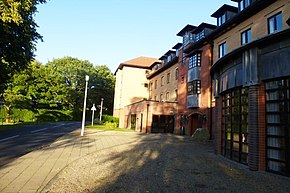|
Grey College, Durham
Grey College is a college of Durham University in England, founded in 1959 as part of the university's expansion of its student population. The college was originally planned to be named Oliver Cromwell College, but this proved too controversial.[3][4] Instead, the college is named after Charles Grey, 2nd Earl Grey, who was Prime Minister of the United Kingdom at the time of the university's foundation.[4] The student population of Grey College consists of around 1,351 students, made up of just over 1,200 undergraduate students and a further 150 postgraduate students.[1] The college is fully catered.[1] History Founded in 1959, Grey was the first college of the university's post-war expansion,[4] and the second college to open on Elvet Hill after St Mary's.[5] It was also the last college founded before the separation of Durham and Newcastle in 1963. The college initially only admitted men, but has been mixed since 1984.[4] In March 1959, just a few months before the opening of the college, the Elvet block (then the main block of the college) was devastated by fire. However, the college recovered to open as scheduled in October and adopted the phoenix as its unofficial badge.[4] The college coat of arms features a scaling ladder (or gré — the badge of the Grey family) between two St Cuthbert's crosses (the symbol of Durham). A new grant of arms in 2004 confirmed these and added the phoenix as a crest.[6] Fountains Hall was completed in 1971 and the Lattin Chapel, named after former college bursar Frank Lattin, was consecrated on 18 November 1973 by the Bishop of Durham, John Habgood.[7] During the 1966 World Cup, Grey College was home to the Soviet Union's football team who were playing their group matches in Sunderland and Middlesbrough.[8] They won all their matches while based in Durham, but eventually lost to West Germany in the semi-finals. Grey College was exclusively for male students until the start of the 1984–1985 academic year, when a contingent of nineteen women joined the college in their first year as a pilot programme.[4] These first female members of the college had been assigned to Grey, rather than having chosen it, since they had not specified a college of residence at the time they had applied to the University of Durham. Few changes were made to accommodate the new mixed-sex living arrangements—toilet and bathroom facilities were shared, for instance. Female students could, however, request lace curtains in addition to the regular fabric curtains for their rooms.[citation needed] In the following year, 1985–1986, Grey College opened its doors to all women, who could now actively apply to join the college. By the time these women had graduated three years later, Grey had become indistinguishable in population from the other mixed-sex colleges of the university.[citation needed] In 1992 a plan to construct a fourth accommodation block was announced. This became Holgate House, named after the college's first Master, Sidney Holgate, and was opened in 1996.[9] The Victor Watts Memorial Library, named after the college's third master, opened as an extension to Holgate House in 2005.[10] Buildings There are four accommodation blocks on site: Hollingside (the main building), Elvet, Oswald, and Holgate House. The college offers a number of other facilities: Hollingside contains the 280-seat dining room, the college bar, and the Junior Common Room (JCR), which has the largest TV of any Durham college.[citation needed] Holgate House has a conference centre and a library with over 7,000 books. A fifth building, Fountains Hall, is the home of Phoenix Theatre Company (PTC), the college chapel, a multi-purpose hall (for everything from badminton to band practice), and a toastie bar. The Durham University Botanic Garden and the High Wood are located next door to the college, and a path leads directly to the Mountjoy Site (formerly known as the Science Site). College lifeNotable social events include "The Informal or Winter Ball"; the "President's Guest Night" and "Grey Day", a music festival following the end of the examination period. The year comes to an end with "The Phoenix Ball", the largest and most lavish social event of the year. Grey has a large number of sports clubs, ranging from Grey College Boat Club through Grey College Ultimate Frisbee Club to team croquet. Many of Grey's sporting clubs have enjoyed success in recent years, notably the women's hockey team, boat club, darts team, rugby team, football team, cheerleading squad and Ultimate Frisbee Club. Members of the college sometimes refer to themselves as the "Grey Army" and can be found at many college sporting events (usually rugby games) supporting the team, with a "Commander-in-Chief" appointed by the JCR each academic year to lead the troops. Another mascot of the college is the "College Trout"—a Big Mouth Billy Hamill toy that is currently stationed behind the bar. A bi-annual magazine, Grey Matter, also exists to satirise college events. The college has a fellowship in mathematics (the Alan David Richards Fellowship) and a general fellowship scheme (the Sidney Holgate Fellowships), which includes funding for research fellows and an artist in residence. Notable students
Fellows
Masters and principalsThe head of college was titled 'master' until 2023, when the title of 'principal' was adopted by Sonia Virdee, the first woman to be the head of the college.
References
Further reading
External links |
|||||||||||||||||||||||||||||||||||||||||||||||||||||||||



